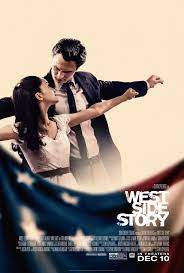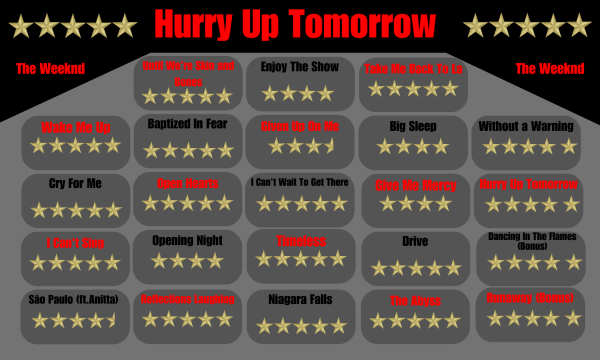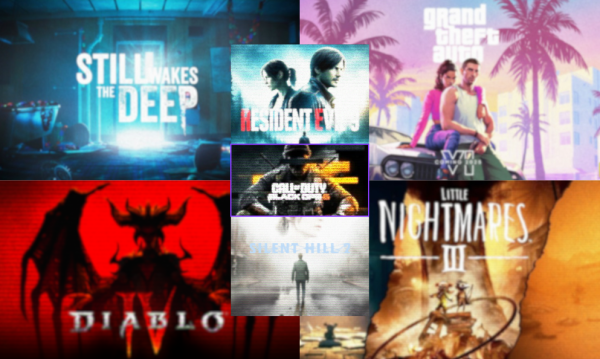West Side Story: Anita, blue, and snapping
West Side Story:

In the same way hearing the Star Wars theme creates images of lightsabers and Yoda, the high-pitched whistle in the beginning of West Side Story conjures images of snapping, swirling skirts, and fire escapes. West Side Story (released in 2021, directed by Stephen Spielberg) is a triumph in nearly every way. The direction, acting, dancing, and singing are all spectacular. From the opening shots and scenes, West Side Story hooks you and refuses to let go even after the credits begin to roll.
West Side Story (WSS) is the most well-known Romeo & Juliet adaptation, set in the 1950s in the west side of New York City against the backdrop of gentrification and racism. Gone are the Montague and Capulet families, replaced by the Jets and Sharks, rival gangs led by Riff (the Mercutio of this story, played by Mike Faist) and Bernardo (the Tybalt portrayed by David Alvarez) respectively. At a ‘Dance at the Gym’ that both the Jets and Sharks attend, former Jet- Tony (Ansel Elgort as this story’s Romeo)- and Bernardo’s sister María (WSS’s Juliet played by Rachel Zegler in her incredible debut)- fall in love. While the two attempt to make a future together, tensions between the Jets and Sharks escalate in a violent confrontation that leaves two dead, and the shockwaves of which lead to the death of another. As I was leaving the movie, I remarked that West Side Story was the 36-hour-guide to ruining as many lives as possible.
West Side Story has always been somewhat of an anomaly, walking the line between grit and r
ealism while also featuring a sweeping score (composed

by Leonard Bernstein with lyrics by Stephen Sondheim) and star-crossed lovers. It’s hard to imagine a story in which snapping and beautiful choreography can coexist with the threat of violence, but Spielberg expertly navigates this line, creating a movie that indulges in big-production musical numbers while making space for somber and quiet moments. Romeo & Juliet is impressive in its ability to portray the highs and lows of human life in 2 hours, and WSS takes this and runs with it- making the 150 minute run-time into a whirlwind of joy, sorrow, despair, and hope. Tony Kushner’s script only elevates the directional choices, giving the characters new life. It’s less like watching a movie and more like witnessing the private moments in real people’s lives.
This feeling can largely be credited to the performance given by the entire cast, but Ariana DeBose as Anita (Bernardo’s longtime girlfriend) will forever be a standout. DeBose reaffirms Anita’s status as the best character while also adding her own flair.

Anita is all at once funny, compassionate, hurting, loyal, disappointed, and determined. She experiences loss and pain while remaining a supportive and stabilizing force for María, protecting and guiding her with experience beyond her years. If nothing else, I hope West Side Story reminds us all that Anita is the true main character and hero of the narrative. (This is something echoed by WSS’s costume designer, Paul Tazewell, who said of Anita’s yellow dress in an interview: “Anita is the sun. All her energy radiates and seeps onto everyone around her, bringing them hope as well.”)
The added scenes between Anita and Bernardo flesh out their relationship in a new way, granting it the complexities of real human connection while also foreshadowing as the audience realizes the pair will never get the future they are planning. María and Tony get the same treatment, both with the foreshadowing of disaster and with new scenes for the couple. We actually witness the two go on a date, we see them disagree, make up, and grow closer. The permanent situation of Romeo & Juliet in everyone’s consciousness aids this part of the plot, and even as you understand María and Tony (or Anita and Bernardo) will not end up together, you never stop rooting for them.
This is also true of the Jets, whom I kept hoping would make better decisions. If Anita is dressed in yellow to represent the sun, and María is dressed in white with red to highlight her coming of age (again according to Tazewell), I feel that blue represents trouble within WSS. The Jets are the primary aggressors in the story, both instigating and escalating situations. Riff especially thrives on conflict and enjoys making trouble. It’s the Jets who attack the Sharks, the Jets who propose the rumble, and the Jets who bring the gun to the rumble. It is also the Jets that wear cool shades of blue and gray while the Sharks wear yellows and oranges. Bernardo himself even says that the Sharks are “Stupid” when dissuaging Chino (Josh Andrés Riverra as the Paris substitue) but acknowledges that it is a necessity to protect them and their community. The Sharks are recent Puerto Rican immigrants that face hardship and discrimination on all sides, from struggles getting hired and finding housing to not being able to rely on the police to keep them safe. The Sharks are reactionary, and spent most of the story simply trying to survive. The Jets are the antagonists, and this creates the lens through which the audience sees the rest of the movie- a lens in which characteristics of the Jets, like the snapping or blue, come to symbolize trouble and create feelings of wariness.
Furthering this are outfits worn by María, Tony, and Anita throughout the movie. In Spielberg’s film, Tony’s backstory is given more time. We learn that he has recently gotten out of jail for a year and that he has left the Jets, but we also learn that he was in jail for nearly beating another teenager to death during a rumble. This violence is brought back during the actual rumble that takes place on screen. We see Tony’s beating of Bernardo as a horrible deja vu, a reminder that Tony has a history of being violent. When Tony stops punching Bernardo, the relief is palpable; the audience tells themselves Tony has changed. Spoiler- And this hope for Tony’s redemption is shattered when he ends up stabbing and killing Bernardo only a short while later-spoiler ends.
Throughout the entire movie, Tony wears clothes that are blue, but they are always paired differently. The Jets have blue/gray shirts with jeans and sneakers while Tony wears blue button-ups with khaki pants and brown jackets. It looks as though Tony is attempting to cover up his connection to the Jets, to leave them behind, but the blue follows him and he’s never able to escape it. María wears two distinctive blue dresses in the movie, a light blue when she goes to work, and a dark one at the end of the movie. Both times that she wears these, something bad happens. Spoiler– While wearing the light blue, María is told Bernardo is dead, and while wearing the dark blue (which appears red for a brief moment), Tony dies- spoiler ends. María is beginning to wear colors more like Tony, and is also becoming more involved and affected by his problems, and the trouble.
Trigger warning for assault. When Anita goes to Doc’s Drugstore (where Tony is waiting for María) to tell him the time to expect María, she is wearing a dark purple dress (spoiler– the same one she was wearing while identifying Bernardo in the morgue-spoiler ends). As Anita enters the drugstore, she sees that a large group of Jets have assembled along with Riff’s girlfriend Graziella (Paloma Garcia-Lee) and another Jet girlfriend Velma (Maddie Ziegler). Anita attempts to leave, but the Jets block her exit and begin to play music, threatening her and forcing her to dance with them. Graziella and Anita reach for one another (the two of them reaching for each other tore my heart open), but the Jets throw Grazi and Velma out and lock the doors while Anita is assaulted. Thankfully, the owner of Doc’s Drugstore, Valentina (Rita Moreno), interrupts and saves Anita. In this moment, all of the pain and fear that has taken place on screen is shown to us and it’s blue. Obviously, I didn’t design the costumes and I don’t know what Tazewell’s intentions were exactly, but his costuming was stunning and this was what I thought of while watching the movie. Some part of me kept waiting for the Jets to let Anita go and be civil, and I remember my heart dropping when they didn’t. The Jets respond to change by putting anger back into the world (María comments to Tony that Riff steals hope from other people) and the Jets are the ones who lay the foundation for violence and pain.
Even when the characters disappointed me, the production of the musical numbers never did. I was interested in, if not slightly apprehensive about, where the songs ‘Cool’, ‘Gee, Officer Krupke’, and ‘America’ would be placed in the narrative. Some iterations of the story see ‘Cool’ take place after the rumble, as the Jets attempt to calm themselves down, made hyper by their grief for spoiler- the deceased Riff- spoiler ends. Other versions place ‘Cool’ before the rumble with Riff telling the Jets to calm down. This is easily my least favorite placement as Riff acting as a descolator is laughable at best. The same thing holds true for ‘Gee, Officer Krupke’ (which occasionally takes place in the first act or second act depending on the placement of ‘The Rumble’) and ‘America’ (which is always a first-act song, but sometimes happens before Tonight and sometimes happens after.) I liked the extended conversation between Anita and Bernardo preceding ‘America’, and the choice to set ‘Gee, Officer Krupke’ in the actual police station where Officer Krupke (Brian D’Arcy James) works adds a new edge to the song in a fresh way. These choices felt so natural that when the opening notes of ‘Cool’ began any potential fears had been erased entirely. ‘Cool’ is put before the rumble but after the gun has been bought. Tony, trying to stop the fight, has tracked Riff down and is attempting to take the gun from him. ‘Cool’ is the struggle for the gun as Riff and Tony dance around one another, trying to maintain the upper hand. Ultimately, Riff wins and the gun is taken to the rumble where it is dropped and picked up by a grieving Chino (spoiler-who is seen cradling Bernardo’s body-spoiler ends). Spoiler- the gun that Riff buys to ‘protect’ himself is the one that ends up killing Tony– spoiler ends.
The gun serves not only as a weapon, but as a symbol of the larger problems surrounding the characters. They live in a world where adults enable children, with an adult selling Riff the gun, and the officers apathy towards stopping the Jets behavior. It is a reminder that violence escalates, and volatile situations are not cured by fighting. It shows us the dangers of normalizing violence, creating a dichotomy between how the characters act versus how they react to violence around them. (Spoiler– the pure look of horror on Bernardo’s face as Riff runs into his knife personifies this-spoiler ends.) The movie implores us to hope, but never shies away from the truth of the situation.
The benefit of Spielberg’s WSS being a readaptation and not a remake (as many people complained) is that it is given the liberty to mess around with creative elements as it sees fit. It isn’t trying to be any other version of WSS; it is fully its own. For all of those convinced it’s a remake, it’s actually a readaptation of the original 1957 script, not the 1961 film.
If I made any changes to the movie, it would be to give the Sharks more screen time. If the Jets get ‘Jet Song’, it would be neat to have the Sharks get a ‘Shark Song’. The expansion of the scene around ‘America’ helps this, but if the effort is put in to give Bernardo a better backstory as a boxer, then I want to see more effort put in to show their day-to-day lives. Spoiler for the rest of this paragraph: The only other thing I wanted to be different was the very end. After Chino has shot Tony, and Tony has died, the Sharks and Jets together pick up his body and move him into Doc’s Drugstore while María trails behind them, and Valentina walks Chino to the front of the shop where the police arrive. Instead of Chino being presumably taken into custody, I wish Chino had also been taken inside the store. Tony is allowed to be sympathetic after killing Bernardo, and paralleling this with Chino’s loss of innocence throughout the film better serves the idea that the feud between the Sharks and Jets has ended. Too much life has been lost, the Jets are disbanding, and the neighborhood is disappearing anyway. It could instead end with the entire party walking into the store as if to say: It is done, and now these characters must continue to go on.
Overall, WSS is a gorgeous movie-musical made with love, passion, and no small amount of talent. Everything from the color palette, to the costumes, singing, and acting are impeccable. I can only hope that it will get the success it didn’t get in theaters on streaming, and hope that people will begin to readjust the benchmark for what makes a film financially successful. In the meantime, I’m going to reread Romeo & Juliet, listen to the album, and watch DeBose get the accolades she deserves.
9.6/10 would go to a Dance at the Gym again
Further breakdown:
Writing Quality: 9/10 Enjoyability: 9.5/10
Pace: 9/10 Visual elements: 10/10
Plot development: 9/10 Insightfulness: 9/10
Characters: 10/10
Further information:
It came to my attention after seeing the movie that Ansel Elgort had been accused of assault, and I felt it would be important to include information from another source as I wasn’t qualified to explain the topic in detail. Vulture’s article on the topic.
Additionally, I’ve included a link to a website for RAINN, an organization dedicated to helping survivors of assault. RAINN.
Lastly, WSS is a piece of media that has always been critiqued for its portrayal of its Puerto Rican characters, so I’ve included several articles and a TED Talk with varying opinions to provide perspectives and experiences beyond my own.
TED Talk by Chimamanda Ngozi Adichie.
Feeling Pretty: West Side Story and U.S. Puerto Rican Identity, an excerpt from the book “Boricua Pop” by Frances Negrón-Muntaner
I feel not so pretty about the new ‘West Side Story’ by Julio Ricardo Varela
Latinas HAVE THOUGHTS on ‘West Side Story’ by Mujeres Problemáticas
Interview: Rachel Zegler And Ariana DeBose Talk ‘West Side Story’, Sisterhood & Stepping Into Their Roles by Britany Murphy





